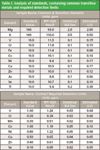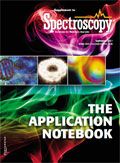EDXRF Analysis of Trace Elements in Aqueous Solution with UltraCarry
Elemental analysis of aqueous solutions into the low ppm and sub-ppm concentration ranges is demonstrated, using the advanced Cartesian geometry Rigaku NEX CG Energy Dispersive X-ray Fluorescence (EDXRF) spectrometer in conjunction with the patented UltraCarry? sample preparation technique.
Elemental analysis of aqueous solutions into the low ppm and sub-ppm concentration ranges is demonstrated, using the advanced Cartesian geometry Rigaku NEX CG Energy Dispersive X-ray Fluorescence (EDXRF) spectrometer in conjunction with the patented UltraCarry® sample preparation technique.
Trace element analysis of aqueous-based solutions is important in many areas, such as industrial manufacturing, quality control (QC) and quality assurance (QA) processes, environmental monitoring and remediation, as well as agriculture and general research.
To meet the challenges of trace analysis into the ppb range, Rigaku offers the NEX CG EDXRF analyzer and the UltraCarry sample preparation disk. With the Rigaku system, trace analysis can be carried out by non-technical operators and experts alike, without the need for special scientific training and costly, complicated, time consuming sample preparation.
Experimental Conditions
Analysis was performed with the NEX CG EDXRF analyzer and the UltraCarry sample preparation disk. UltraCarry is a novel disposable (single-use) sample carrier used to preconcentrate aqueous samples into a uniform thin film that is optimized for the suppression of background noise.
200 μL of each sample was pipetted onto the center of the UltraCarry pad. Samples were then dried using Rigaku UltraDry vacuum hotplate (75 Torr @ 68 °C for 15 min), followed by direct analysis with the NEX CG analyzer.
Results
A standardless calibration method was built using the Rigaku RPF-SQX fundamental parameters (FP) template for UltraCarry. RPF-SQX is an advanced FP program that automatically deconvolutes spectral peaks and models the thin film sample matrix using first principles. Providing a semi-quantitative measurement of concentrations without the need for known assayed calibration standards, the approach may be used for general screening and monitoring of aqueous solutions, industrial effluents as well as rinse and waste waters. Further refinement of the FP method may be effected by employing a Matching Library using from one to a few assayed samples to model a specific matrix. To demonstrate the standardless FP method, two certified ICP standards, containing common transition metals, were analyzed for 1200 s.

Table I: Analysis of standards, containing common transition metals and required detection limits
Conclusions
The Rigaku NEX CG combines secondary and polarization target excitation, with a high performance SDD detector, to deliver optimal EDXRF sensitivity. In conjunction with UltraCarry, the NEX CG is an ideal tool for the trace elemental analysis of aqueous solutions down to parts-per-billion levels. This technique is suitable for many analyses, including industrial and environmental applications.
Applied Rigaku Technologies, Inc.
9825 Spectrum Drive, Bldg. 4, Suite 475, Austin, TX 78717
tel. (512) 225-1796
Website: www.RigakuEDXRF.com
